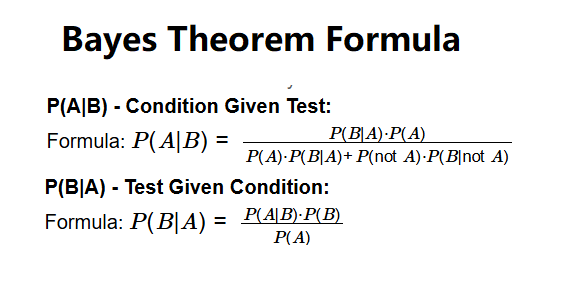1. What is a Bayes' Theorem Calculator?
Definition: This calculator applies Bayes' theorem to compute either the probability of a condition given a positive test result (\( P(A|B) \)) or the probability of a positive test given a condition (\( P(B|A) \)). It is tailored for medical diagnostics, such as allergy testing, to evaluate test reliability.
Purpose: It supports medical diagnostics by providing accurate probabilities, helping clinicians assess the likelihood of conditions or test outcomes.
2. How Does the Calculator Work?
The calculator uses two formulas:
- P(A|B) - Condition Given Positive Test:
- Formula: \( P(A|B) = \frac{P(B|A) \cdot P(A)}{P(A) \cdot P(B|A) + (1 - P(A)) \cdot (1 - P(\text{not } B|\text{not } A))} \)
- Inputs:
- \( P(A) \): Prevalence of condition.
- \( P(B|A) \): Sensitivity (positive test given condition).
- \( P(\text{not } B|\text{not } A) \): Specificity (negative test given no condition).
- P(B|A) - Positive Test Given Condition:
- Formula: \( P(B|A) = \frac{P(A|B) \cdot P(B)}{P(A)} \)
- Inputs:
- \( P(A|B) \): Probability of condition given positive test.
- \( P(B) \): Probability of positive test.
- \( P(A) \): Prevalence of condition.
Steps:
- Choose method: \( P(A|B) \) or \( P(B|A) \).
- For \( P(A|B) \): Enter Prevalence, Sensitivity, Specificity (%).
- For \( P(B|A) \): Enter \( P(A|B) \), \( P(B) \), \( P(A) \) (%).
- Validate: Inputs between 0% and 100%; no division by zero.
- Convert percentages to decimals.
- Compute result using the selected formula.
- Display result as percentage to 2 decimal places.
3. Importance of Bayes' Theorem Calculations
These calculations are vital for:
- Medical Diagnostics: Determining true probabilities of conditions or test results, enhancing test accuracy.
- Risk Assessment: Quantifying probabilities in medical scenarios.
- Decision-Making: Supporting clinical decisions with probabilistic evidence.
4. Using the Calculator
Examples:
- P(A|B) - Condition Given Positive Test:
- Allergy test: Prevalence = 10%, Sensitivity = 95%, Specificity = 90%.
- \( P(A) = 0.1 \), \( P(B|A) = 0.95 \), Specificity = 0.9.
- \( P(\text{not } A) = 0.9 \), \( P(B|\text{not } A) = 1 - 0.9 = 0.1 \).
- \( P(B) = (0.1 \cdot 0.95) + (0.9 \cdot 0.1) = 0.095 + 0.09 = 0.185 \).
- \( P(A|B) = \frac{0.95 \cdot 0.1}{0.185} \approx 0.5135 \approx 51.35\% \).
- Result: 51.35% chance of allergy given positive test.
- P(B|A) - Positive Test Given Condition:
- Allergy test: \( P(A|B) = 51.35\% \), \( P(B) = 18.5\% \), \( P(A) = 10\% \).
- \( P(A|B) = 0.5135 \), \( P(B) = 0.185 \), \( P(A) = 0.1 \).
- \( P(B|A) = \frac{0.5135 \cdot 0.185}{0.1} \approx 0.95 \approx 95.00\% \).
- Result: 95.00% chance of positive test given allergy.
5. Frequently Asked Questions (FAQ)
Q: What is Bayes' theorem?
A: A formula to update probabilities based on evidence, critical for diagnostics.
Q: Why choose between P(A|B) and P(B|A)?
A: \( P(A|B) \) assesses condition likelihood given a test; \( P(B|A) \) evaluates test outcome given a condition.
Q: What if inputs yield invalid results?
A: The calculator validates inputs to ensure results are between 0% and 100%.
 Home
Home
 Back
Back
